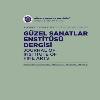Türkiye'de Buğday (T. aestivum L.) Ekim Alanı, Üretim ve Veriminin Krigging Yöntemi ile Değerlendirmesi
Bu çalışmanın amacı Krigging metodu ile Türkiye’de buğday yetiştiriciliği yapılan illerin ekim alanı, üretim ve verimi bakımından benzerlik ve farklılıklarının saptanması ve potansiyellerinin belirlenmesidir. Buğday Türkiye için önemli ve stratejik bir ürün olup bitkisel üretim, gıda sanayi ve hayvan beslenmesinde kullanılmaktadır. Çalışmalar ekim alanı, üretim ve verim arasında önemli ilişki olduğunu ortaya koymuştur. Buğdayın ekim alanı, verim ve üretim miktarında iklim, topografya ve toprak koşulları önemli faktörler olarak karşımıza çıkmaktadır. Bunun yanı sıra verimi yüksek, soğuğa ve kurağa daha dayanıklı, vejetasyon süresi kısa çeşit kullanımı da buğdayda ekim alanı, verim ve üretim miktarında artışlara neden olmaktadır.
Anahtar Kelimeler:
Buğday, Ekim alanı, Üretim miktarı, Verim, Krigging metod, Harita ve Türkiye
Evaluation Acreage, Production and Yield of Wheat (T. aestivum L.) by Krigging Method in Turkey
The purpose of this study was to reveal similarities and dissimilarities of provinces and to determine the potential of provinces on wheat in terms of for acreage, production and yield by using krigging method in Turkey. Wheat is the most important and strategic crop for Turkey and plays important a role in crop production, food industry and animal husbandry whether it is given greater importance in production marketing and valorization. Results revealed that, significant relationships appear between acreage, production and crop yield. Besides, climatic, topographic and soil conditions are very significant factors in determining acreage, yield and production of wheat. The use of cultivars having higher yield, more tolerance to drought cold, and have a shorter growing period allowing rapid development will increase crop, yield therefore acreage and production.
Keywords:
Wheat, acreage, crop production, crop yield, krigging method, map and Turkey.,
___
- Acevedo E, Fereres E (1993) Resistance to abiotic stress. In Hayward MD, Bosemark NO, Romagoza I (eds) Plant Breeding Principles and Prospects, Chapman and Hall. London, U.K., pp 406-4
- Altınbaş M, Tosun M, Yüce S, Konak C, Köse E, Can RA (2004) Effects of genotype and location on the grain yield and some quality traits in bread wheats ( T.aestivum L.). Ege Üniv. Ziraat Fak. Dergisi 41 (1): 65-74
- Anonymous (2006) FAO (Food and Agriculture Organization of the United Nations) 2006 FAO Statistical Databases Available from: http://faostat.fao.org
- Anonymous (2012) TUIK (Turkey Statistical Institution) TUIK Statistical Databases Available from: http://tuik.gov.tr
- Charles R, Jolliet O, Gaillard G, Pellet D (2006) Environmental analysis of intensity level in wheat crop production using life cycle assessment. Agriculture, Ecosystems and Environment 113: 216–225
- CIMMYT (1996) CIMMYT 1995–96 world wheat facts and trends: understanding global trends in the use of wheat diversity and international flows of wheat genetic resources. Mexico, DF.
- Cook RJ, Veseth RJ (1991) Wheat health management. The American Phytopathological Society, St. Paul, Minnesota 55121, USA.
- Curtis BC (2002) Wheat in the world. In Curtis BC, Rajaram S, Gómez H, Macpherson (eds) Bread wheat ımprovement and production, FAO Plant Production and Protection Series, ISBN 92-5104809-6, pp 12-29
- Curtis BC (1982) Potential for a yield increase in wheat. In Beltsville MD (ed) Proc. Natl. Wheat Res. Conf. National Association of Wheat Growers Foundation, USA, 26-28 Oct., Washington, DC, pp 5-19.
- Dalrymple DG (1986) Development and spread of highyielding varieties of wheat in developing countries. Washington, DC, Bureau for Science and Technology, Agency for International Development, US Government Printing Office.
- Erdogan S (2010) Modelling the spatial distribution of dem error with geographically weighted regression: an experimental study. Computers and Geosciences 36: 34–43.
- Fischer RA, Maurer R (1978) Drought resistance in spring wheat cultivars. I. Grain yield responses. Aust J. Agric Res 29: 897-912.
- Jones G, Davis R (2000) Using a synoptic climatological approach to understand climate viticulture relationships. International Journal of Climatology 20: 813-837.
- Kanbertay M (1994) Ege Bölgesinde altı yerde yetiştirilen on ekmeklik buğday çeşidinin verim ve kalite yönünden incelenmesi. Bitki Islahı Bildirileri (Cilt II). Tarla Bitkileri Kongresi, 2529 Nisan 1994, İzmir, s 34-37.
- Keser M, Bolat N, Altay F, Çetinel MT, Çolak N, Sever AL (1999) Çeşit geliştirme çalışmalarında bazı stabilite parametrelerinin kullanımı. Orta Anadolu Hububat Tarımını Sorunları ve Çözüm Yolları Semp. Konya s 64-69.
- Leonard WH, Martin JH (1963) Cereal crops. New York, NY, USA, MacMillan Publishing.
- Orth RA, Shellenberger JA (1988) Origin, production, and utilisation of wheat. In Pomeranz Y (ed) Wheat chemistry and technology. 3. St Paul, MN, USA, American Association of Cereal Chemists.
- Partigöç F, Olgun M (1999) Bazı buğday çeşitlerinde verim stabilitesi üzerine bir araştırma. Orta Anadolu Hububat Tarımını Sorunları ve Çözüm Yolları Semp., Konya, s 597-601.
- Percival J (1921) The wheat plant. A monograph. New York, NY, USA, E.P. Dutton & Company. Peterson RF (1965) Wheat botany, cultivation and utilization. New York, NY, USA, Interscience Publishers.
- Richards RA, Rebetzke GJ, Condon AG, van Herwaarden AF (2002) Breeding opportunities for ıncreasing the efficiency of water use and crop yield in temperate cereals. Crop Sci 42:111–121. Tuğay ME (2012) Türk tarımında bitkisel üretimi artırma yolları. Tarım Bilimleri Araştırma Dergisi 5 (1): 01–08.
- Tuğay ME, Akdağ C (1989) Türkiye iklim ve tarım bölgeleri. Sivas Yöresinde Tarımın Geliştirilmesi Sempozyumu, 30 Mayıs-3 Haziran, Sivas.
- Yılmaz A, Dönmez Ö, Kınacı E (1993) Konya hububat tarımında bazı yetiştirme tekniklerinin önemi. Konya’da Hububat Tarımının Sorunları ve Çözüm Yolları Sempozyumu, 12-14 Mayıs, Konya, s 98-109.
- ISSN: 2146-1880
- Yayın Aralığı: Yılda 2 Sayı
- Başlangıç: 2000
- Yayıncı: Artvin Çoruh Üniversitesi Orman Fakültesi
Sayıdaki Diğer Makaleler
Murat OLGUN, Saffet ERDOĞAN, İmren KUTLU, Nazife Gözde AYTER, Zekiye BUDAK BAŞÇİFTÇİ
